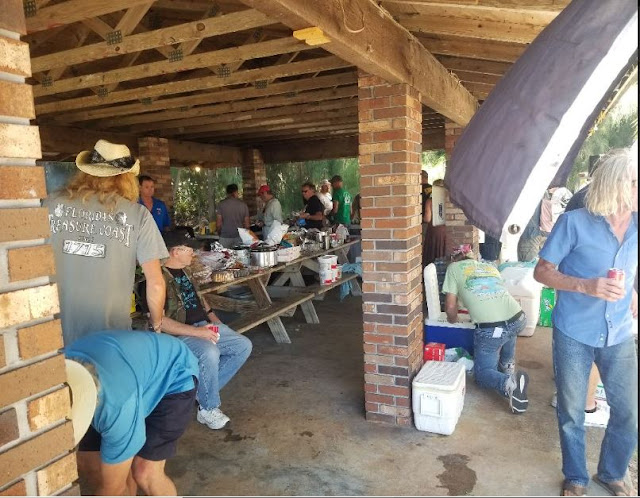Written by the TreasureGuide for the exclusive use of treasurebeachesreport.blogspot.com.
 |
| Blue Hemingray 19 Insulator. |
I recently added a couple finds to my insulator collection. One is a green Hemingray - No 9. (below), and the other is the blue No. 19 Hemingray shown above.
The green one is in very nice condition. Otherwise it is nothing very special.
When I first saw it I thought it was broken because just a small piece of it was sticking out of the sand. I almost didn't take the time to dig it up, but was glad I did.
It was just walking along and area where I've been many times before and wasn't really expecting much of anything because of the accumulating sand. It was certainly not the place to expect coins.
 |
| Hemmingray No. 9 Insulator. |
The blue insulator is the better one. I don't know how much it is worth, but I saw the following ad.
---
HEMINGRAY
[070] (F-Skirt) HEMINGRAY (R-Skirt) No 19 SDP
Cobalt Blue . . . . . . . . . . . $350-400
The least expensive Cobalt Blue insulator you can find! Be careful not to confuse this color with the very common Hemingray Blue.
---
I don't know if it is worth that much, but it is my first blue insultor, so I'm happy to add it to my collection. Now I have to learn if it is cobalt blue or just blue.
I always like sight finds, even if they are not metal. I like a variety of types of treasure - not just metallic. Keep your eyes open whether you are metal detecting or not.
I also learned that there are fake insulators. They make copies of virtually anything that might have some value.
I'm amazed by the different ways that insulators are altered and faked. They are altered and faked just like coins.
---
Here is the beginning of big treasure story written by Thomas Whittle for Freedom Magazine, June 1986. The title is The Mystery of the $30 Billion Treasure.
Here is the beginning.
You are about to read a story that strains the imagination. It is about the disappearance of a fortune of up to $30 billion in gold bullion. When it was first presented as a “tip” to a Freedom Magazine reporter in El Paso, Texas, in 1981, it was discounted as beyond belief. However, when dozens of unrelated, independent sources began to corroborate the story, it could no longer be disregarded, no matter how bizarre. The following story, constructed from personal interviews, documents and confidential reports, is the result of a five-year investigation...
In one of the most closely guarded crimes of recent history, hundreds, perhaps thousands, of tons of gold bullion were secretly and illegally removed from caverns on White Sands Missile Range in New Mexico, the beneficiaries allegedly including former President Lyndon Johnson and individuals connected with the U.S. Army, the Central Intelligence Agency and organized crime.
The caverns are located in and around Victorio Peak, in a remote, rugged section of south-central New Mexico...
And here is the link for the rest of the article.
Thanks to DJ for that link.
Good reading.
---
I received the following review of the annual Treasure Hunter's Cookout.
Treasure Guide,
Hello Friends!
What a wonderful time at the 11th annual Treasure Hunters Pic Nic, I had the pleasure to visit with some really interesting folks and seriously sincere Hunters whom some I knew, and others who I had the pleasure meeting.
For the short time I was there, I reflected on my time in Base Camp in Afghanistan during Operations with all the men whom appeared to look like us during during Operation Enduring Freedom, as we deployed to that area of the world.
One senior officer was reported saying he looked at us as "Pirates of the Caribbean" all of us,, not just one particular unit...
"I mean that with respect, to all who attended this gala."
Terry Shannon and friends, Capt. Fizzmer, Taff Fisher, 1715 Captains, The Masters from NC, Capt. White, Capt Dominic to name a few...
If I missed anyone else it's was because it was so hard to meet every one involved, and the hero of the deep who made this possible.
Food was great and hospitality was what I expected from the "Breathen of the Coast" in a sincere manner.
I also what to mention all these men and women were exceptionally nice to my young son, who they paid attention to while I was talking to the folks there.
I look forward to seeing many of them again soon, and wish all of those passionate treasure Hunters the best of Fortune Safety and Joy these coming seasons.
Thank you from one Veteran to Another.
Respectively,Pirate Booty...
Chris N.
---
Thanks for the report on the huge success of the cookout.
If you missed it this year, you won't want to miss it next year.
---
I just got an email from Bill P. suggesting XRF analysis to determine the content of the white melted pieces. I talked about XRF analysis not too long ago, but didn't think of it in this context.
I think that should do it, if you want to take some samples to a pawn shop or where ever they might do an analysis for you.
Thanks Bill!
---
Happy hunting,
TreasureGuide@comcast.net














